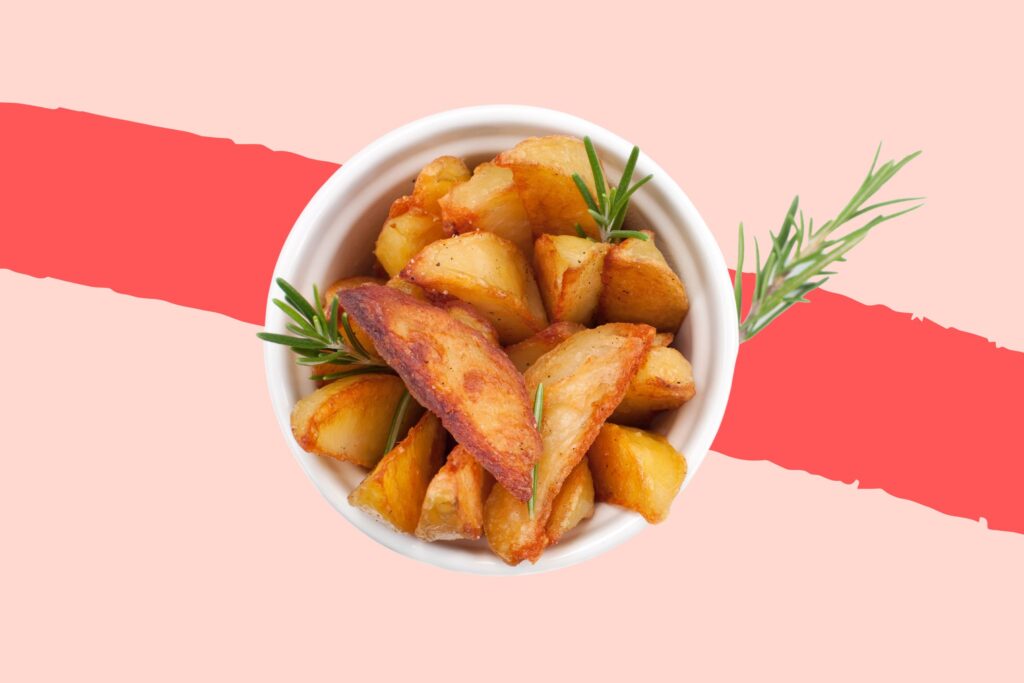Some believe that roast potatoes are the star of the show when it comes to a Sunday lunch, roast dinner, or, well, just about any meal, and there can be a lot of pressure to get them right. Fortunately, we’re experts on doing just that…
The Right Variety
First things first, choosing the right spud variety is essential to the fluffy interior, crispy exterior that we’re surely all seeking. General wisdom suggests that you want a floury- sometimes called fluffy – variety, such as King Edward’s or Maris Piper, as opposed to their waxier cousins.
Keep Things Uniform & Remember To Rinse
Peel your spuds and cut into a medium, uniform size. Making sure they’ll all the same size allows them to cook at the same time.
It’s good to rinse some starch off the spuds, preferably in a sieve or colander under cold, running water. The starch eventually turns into glucose, which caramelises excessively. Burnt edges are not what we’re after, as they won’t crisp. You could even soak your peeled potatoes overnight if you’re patient enough.
Read: 6 different ways of cooking vegetables expertly
Always Boil From Cold
Always, always boil your spuds from a cold start, with a good amount of salt (as much as 15g per litre) in the water. We want them to be soft, fluffy and yielding, but not lose their shape. It’s often a game of who blinks first, but take them as far as you can, as long as they’re still retaining their shape. A little roughed-up around the edges is fine; desirable even.
Fluff Them Up
London restaurant Roast says that “after you par boil your potatoes, make sure to fluff them up, as this will release steam, which dries up the potatoes. This is what makes them nice and crunchy on the outside once they are roasted”.
One failsafe way to get those potatoes fluffy on the inside and crunchy on the outside is to place them in a colander and rattle them around – this will fluff them up help to make the skin crispy.
Dry & Cool
Once your spuds are cool, be careful not to break the potatoes, carefully transfer them to a wire rack to air dry, using a slotted spoon for a controlled transition. Once they’re completely dry and cool, move them to the fridge to get cold.
Again, overnight is best here, as the extra time in the fridge removes any moisture still present, promoting the crispiest finish

Choose Your Oil
The golden rule here is that you must cover your spuds in olive oil, butter, goose or duck fat for that wonderful golden colour.
When it comes to choosing your cooking oil, Roast Restaurant says that “you can use olive oil to cook the potatoes as a healthier alternative but for the ultimate roastie, goose fat is the best to use, you can get this from your local butcher”.
However, here at IDEAL we love to use some of the beef fat that rendered from the roasting process (you can buy more in any good supermarket) to coat your spuds, if you’re having beef, of course.
Heat & Baste
Have your oven heated to 200°C in advance. While they are roasting, baste your spuds in the fat every so often to keep them moist and make them extra crunchy.
Don’t Forget To Season
When your spuds are extra crispy and properly golden brown, take them out and finish with a little more salt. We think rock salt is best here.
Roast concurs “For best flavours, always season with rock salt and fresh herbs. Rosemary and thyme complement roasties beautifully”.
We have to admit that we’re feeling a little hungry after writing that; is it acceptable to have roast potatoes for dinner?




